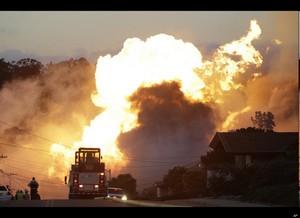InfrastructurePG&E pays additional $70 million for San Bruno natural gas explosion
On Monday, Pacific Gas & Electric Co. (PG&E) announced that it will pay $70 million to residents of San Bruno, California after one of the utility’s natural gas pipelines erupted killing eight people and destroying nearly forty homes

The devistating San Bruno gas pipeline explosion in 2010 // Source: 1hope.org
On Monday, Pacific Gas & Electric Co. (PG&E) announced that it will pay $70 million to residents of San Bruno, California after one of the utility’s natural gas pipelines erupted killing eight people and destroying nearly forty homes.
The Los Angeles Times reports that PG&E will pay the city within the next thirty days, and upon receipt, San Bruno plans on establishing a non-profit to manage the funds and determine how they will be spent.
According to Connie Jackson, San Bruno’s city manager, there are no restrictions on how the money can be used except that they must help pay for programs and public works that benefit the entire community and not just the neighborhood damaged by the explosion.
“This money will be used for the benefit of all the citizens of our city and to help us, as a community, get beyond the tragedy and devastation caused by PG&E’s explosion and fire,” Mayor Jim Ruane told the Times.
The $70 million comes in addition to a $100 million fund that PG&E has already established to help rebuild the neighborhood, compensate victims of the accident, and repair damaged infrastructure. So far roughly $51 million has been spent from the fund.
An investigation into the 9 September, 2010 accident by the National Transportation Safety Board concluded that the utility’s poor maintenance and managerial processes led to the pipeline explosion. In addition state and federal regulators failed to oversee the utility properly.
The pipeline, originally built in 1956, erupted on 9 September sending flames shooting 300 feet into the air for more than ninety minutes before the gas was shut off. Investigators determined that the pipe had several critical welds missing that would have been immediately noticed had the utility inspected the pipe.
In addition, PG&E did not install automatic shut off valves which would have immediately turned off the gas, rather than allowing the fire to burn for more than ninety minutes.
